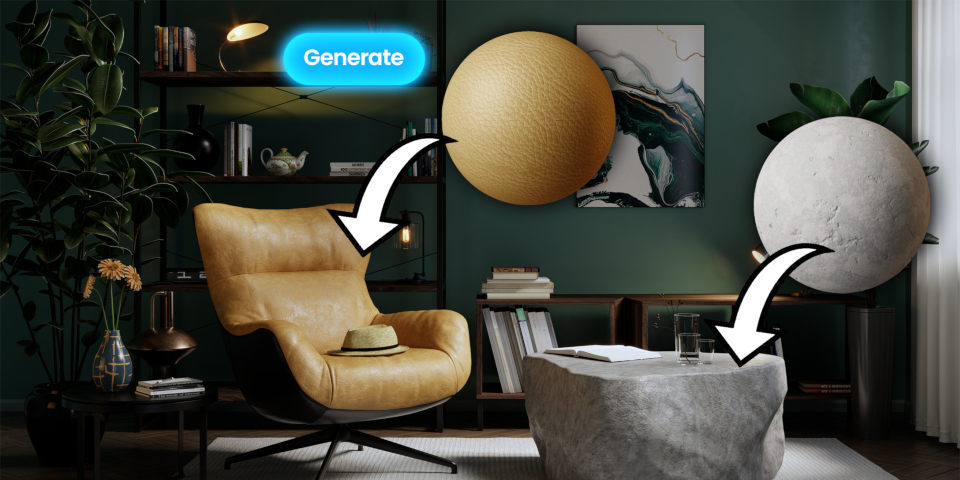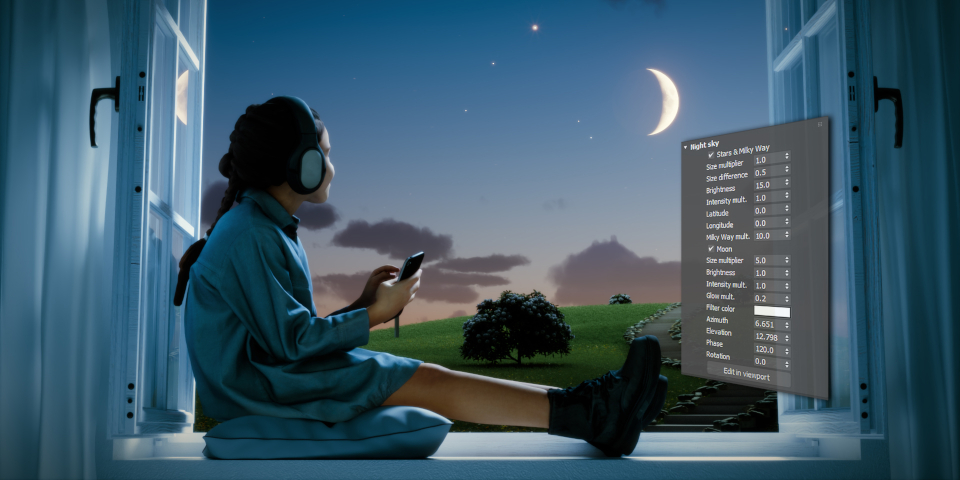Chaos adds new AI tools to V-Ray in V-Ray 7 for 3ds Max, Update 2
Chaos has released V-Ray 7 for 3ds Max, Update 2 (V-Ray 7.2 for 3ds Max), the latest version of the production renderer for architectural visualization, VFX and motion graphics.
The release adds experimental new AI tools for automatically generating PBR materials based on real-world reference images, and generating detail to enhance rendered images.
Other changes include a new procedural Night Sky system, support for clipping volumes with 3D Gaussian Splatting, and support for the new OpenPBR material standard.

Experimental new cloud-based AI material generator and image enhancer
The headline features in V-Ray 7.2 are the new AI tools, both of which are available in beta as part of Chaos Cloud, the cloud-based services included with all V-Ray subscription plans.
The first is the AI Material Generator, which generates a PBR material and texture maps matching a real-world reference photo uploaded to the Chaos Cloud library.
As well as choosing the resolution of the texture maps, users can choose whether to make them tileable, whether to de-light the original image, and the normal and roughness intensities.
The other is the Chaos AI Enhancer, which “automatically identifies and improves people, vegetation and other focal areas in renders”, adding detail not present in the original image.
A new render element, VRayEnhancerData, automatically generates material IDs, object IDs and depth data for the render, after which, it is processed online in Chaos Cloud Collaboration.
We’ve contacted Chaos to ask what data sets the new AI models were trained on, and how the new AI services will be priced once they leave beta, and will update if we hear back.
Updated 27 August 2025: The AI Enhancer will remain free, but some “advanced features” may only be available with V-Ray Premium subscriptions or Collection plans.
Chaos AI Enhancer uses Stable Diffusion which was “trained on pairs of images and captions taken from LAION-5B, a publicly available dataset derived from Common Crawl data scraped from the web”.
The Material Generator was trained on “a mixture of privately curated and publicly available datasets. In all cases we have ensured that the licenses for each dataset are appropriate”.
3D Gaussian Splatting: support for clipping volumes and V-Ray GPU
Support for 3D Gaussian Splatting, introduced in V-Ray 7 for 3ds Max, has been extended, with 3DGS data becoming renderable in V-Ray GPU as well as on the CPU.
It is also now possible to crop 3DGS data using clipping volumes, as shown in the video above, to make it easier to integrate the modelled parts of a scene into a scanned environment.

New procedural night sky system within VRaySun
VRaySun, V-Ray’s physical sun and sky system, gets a new procedural night sky, including the moon, individual stars, and the Milky Way.
The sky can be generated automatically to match a specific real-world location, date and time; or users can adjust the position and brightness of the moon and stars manually.
Materials and textures: new two-sided texture and updates to VRayMultiSubTex
Other new features include the V-Ray Two-Sided Texture, which makes it possible to assign different texture maps to the front and back surfaces of labels, paper or fabrics.
VRayMultiSubTex, which randomizes textures within a material, gets new options to control the probability with which each texture appears.
It is also now possible to apply a mapping source to the MultisubTex sub-maps.
Materials and textures: OpenPBR support
V-Ray also becomes the latest application to support OpenPBR, the new open standard intended to improve the consistency with which materials are displayed in different apps.
The V-Ray Material gets an new OpenPBR shading mode; and 3ds Max’s own OpenPBR material is supported on export.
Chaos Scatter: new Clusters controls
Chaos Scatter, V-Ray’s object scattering system, gets new Clusters settings to generate more realistic clumping of the assets being scattered.
VFB: new Exposure Layer controls, and updates to VRayLightMix
When viewing and managing renders, the V-Ray Frame Buffer (VFB) gets new slider controls in the Exposure Layer to adjust the shadows, light tones and dark tones in the image.
The VRayLightMix render element, which makes it possible to adjust the lighting in a scene after rendering, now supports up to 256 unique light selects.
Performance improvements to V-Ray Proxy and the standalone denoiser
In addition, VRayProxy now supports delayed loading, making it possible to begin work on large scenes while objects load in the background.
When using vdenoise, V-Ray’s standalone denoiser, to denoise a render, it is now possible to discard the extra data it generates, reducing file sizes.
Distributed Rendering 2 available available in a separate build
V-Ray’s distributed rendering system gets a major overhaul, with Distributed Rendering 2 (DR2) improving performance scaling across multiple machines, and providing “enhanced V-Ray GPU features, improved denoiser workflows, two-sided textures, and extended options in VRayLight”.
However, at the time of writing, it is only available in a separate stable build of the software, not the official release.
Other services: 3D streaming in Chaos Cloud, and multi-import from Chaos Cosmos
As well as the new AI features, Chaos Cloud gets experimental support for 3D streaming in the Chaos Cloud Collaboration toolset.
Users can upload a V-Ray scene to the cloud and share a URL through which clients or colleagues can navigate the scene interactively, even on low-powered devices like phones.
It is also now possible to import multiple assets at once from Chaos Cosmos, Chaos’s architectural asset library, which itself got a major update last week.
Price and system requirements
V-Ray 7.2 for 3ds Max is compatible with 3ds Max 2021+, running on Windows 10+. It is rental only. You can find pricing for current subscription plans in this story.
Read an overview of the new features in V-Ray 7.2 on Chaos’s website
Read a full list of new features in V-Ray 7.2 for 3ds Max in the online release notes
Have your say on this story by following CG Channel on Facebook, Instagram and X (formerly Twitter). As well as being able to comment on stories, followers of our social media accounts can see videos we don’t post on the site itself, including making-ofs for the latest VFX movies, animations, games cinematics and motion graphics projects.
